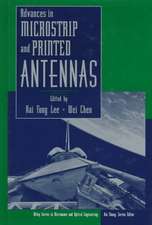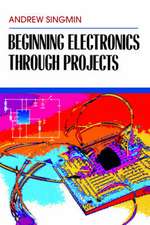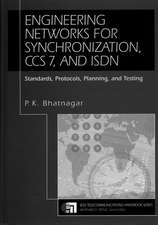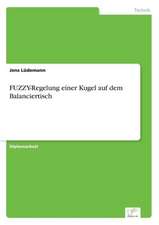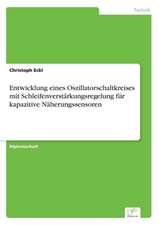Wireless RF Energy Transfer in the Massive IoT Era – Towards Sustainable Zero–energy Networks: IEEE Press
Autor H Alvesen Limba Engleză Hardback – 6 dec 2021
A deep dive into wireless energy transfer technologies for IoT networks
In Wireless Energy Transfer: Towards Sustainable Zero-Energy IoT Networks, distinguished researchers Onel L. A. López and Hirley Alves deliver a robust discussion of massive wireless energy transfer and zero-energy, low-cost, Internet of Things networks. Moving beyond the basic theoretical background of the subject, the authors offer a deep analysis of the scenarios and requirements of wireless energy transfer.
The book details novel powering schemes recently proposed to face the challenging requirements of the future Internet of Things, as well as a comprehensive review of sustainable IoT wireless networks.
Wireless Energy Transfer explains why novel energy efficient solutions will be needed to address the sheer volume of devices currently forecasted to be used in the near future. It explores the challenges technologists and users will face as well as proposed solutions and future research directions.
The authors also discuss:
- Thorough introductions to wireless energy transfer, including energy harvesting sources, radio frequency energy harvesting circuits, efficiency models, and architectures for wireless energy transfer powered IoT networks
- Comprehensive explorations of ambient radio frequency energy harvesting, including measurement campaigns, energy harvesting hardware prototypes, and performance analysis based on stochastic geometry
- Practical discussions of efficient schemes for massive wireless energy transfer, including energy beamforming, multi-antenna techniques, and distributed antenna systems
Perfect for students and researchers in signal processing, communications, networking, and information theory, Wireless Energy Transfer: Towards Sustainable Zero-Energy IoT Networks will also earn a place in the libraries of students and practitioners in the fields of communication hardware and transceiver design.
Din seria IEEE Press
- 5%
 Preț: 599.39 lei
Preț: 599.39 lei - 20%
 Preț: 684.17 lei
Preț: 684.17 lei - 24%
 Preț: 667.15 lei
Preț: 667.15 lei - 24%
 Preț: 1226.95 lei
Preț: 1226.95 lei - 24%
 Preț: 707.88 lei
Preț: 707.88 lei - 24%
 Preț: 702.63 lei
Preț: 702.63 lei - 24%
 Preț: 617.46 lei
Preț: 617.46 lei - 24%
 Preț: 600.44 lei
Preț: 600.44 lei - 24%
 Preț: 741.54 lei
Preț: 741.54 lei - 24%
 Preț: 706.13 lei
Preț: 706.13 lei - 24%
 Preț: 704.88 lei
Preț: 704.88 lei - 24%
 Preț: 695.87 lei
Preț: 695.87 lei - 24%
 Preț: 618.99 lei
Preț: 618.99 lei - 24%
 Preț: 546.25 lei
Preț: 546.25 lei - 14%
 Preț: 858.78 lei
Preț: 858.78 lei - 20%
 Preț: 446.58 lei
Preț: 446.58 lei - 24%
 Preț: 672.04 lei
Preț: 672.04 lei - 24%
 Preț: 612.66 lei
Preț: 612.66 lei - 24%
 Preț: 572.10 lei
Preț: 572.10 lei - 14%
 Preț: 743.46 lei
Preț: 743.46 lei - 23%
 Preț: 1031.28 lei
Preț: 1031.28 lei -
 Preț: 415.98 lei
Preț: 415.98 lei - 9%
 Preț: 1010.21 lei
Preț: 1010.21 lei - 9%
 Preț: 1499.89 lei
Preț: 1499.89 lei - 9%
 Preț: 806.07 lei
Preț: 806.07 lei - 9%
 Preț: 1069.47 lei
Preț: 1069.47 lei - 9%
 Preț: 1117.45 lei
Preț: 1117.45 lei - 20%
 Preț: 723.20 lei
Preț: 723.20 lei - 9%
 Preț: 923.82 lei
Preț: 923.82 lei - 9%
 Preț: 994.01 lei
Preț: 994.01 lei - 9%
 Preț: 963.51 lei
Preț: 963.51 lei - 9%
 Preț: 1969.97 lei
Preț: 1969.97 lei - 9%
 Preț: 1021.22 lei
Preț: 1021.22 lei - 9%
 Preț: 742.90 lei
Preț: 742.90 lei - 9%
 Preț: 1485.82 lei
Preț: 1485.82 lei - 9%
 Preț: 1020.25 lei
Preț: 1020.25 lei - 9%
 Preț: 930.31 lei
Preț: 930.31 lei - 9%
 Preț: 997.70 lei
Preț: 997.70 lei - 9%
 Preț: 970.56 lei
Preț: 970.56 lei - 9%
 Preț: 781.15 lei
Preț: 781.15 lei - 9%
 Preț: 1162.23 lei
Preț: 1162.23 lei - 9%
 Preț: 1030.34 lei
Preț: 1030.34 lei - 9%
 Preț: 815.85 lei
Preț: 815.85 lei - 9%
 Preț: 1130.31 lei
Preț: 1130.31 lei - 9%
 Preț: 1560.74 lei
Preț: 1560.74 lei - 9%
 Preț: 1289.30 lei
Preț: 1289.30 lei - 9%
 Preț: 1036.75 lei
Preț: 1036.75 lei - 9%
 Preț: 968.96 lei
Preț: 968.96 lei - 9%
 Preț: 1130.63 lei
Preț: 1130.63 lei - 9%
 Preț: 1010.82 lei
Preț: 1010.82 lei
Preț: 808.61 lei
Preț vechi: 888.57 lei
-9% Nou
154.75€ • 160.96$ • 127.75£
Carte tipărită la comandă
Livrare economică 14-28 aprilie
Specificații
ISBN-10: 111971866X
Pagini: 256
Dimensiuni: 151 x 244 x 19 mm
Greutate: 0.51 kg
Editura: Wiley
Seria IEEE Press
Locul publicării:Hoboken, United States
Cuprins
Preface ix Acknowledgments xi Acronyms xii Mathematical Notation xvi About the Companion Website xviii 1 Massive IoT 1 1.1 Selected Use-cases and Scenarios 4 1.2 Key Technologies 6 1.3 Requirements and KPIs 10 1.4 Key Enablers 12 1.4.1 Holistic and Globally Scalable Massive IoT 12 1.4.2 Sustainable Connectivity 13 1.5 Final Remarks and Discussions 17 2 Wireless RF Energy Transfer: An Overview 20 2.1 Energy Harvesting 20 2.1.1 EH Sources 20 2.1.2 RF Energy Transfer 22 2.2 RF-EH Performance 24 2.2.1 Analytical Models 24 2.2.2 State-of-the-art on RF EH 26 2.3 RF-EH IoT 30 2.3.1 Architectures of IoT RF EH Networks 30 2.3.2 Green WET 31 2.3.3 WIT-WET Layouts 32 2.3.4 RF EH in IoT Use Cases 32 2.4 Enabling Efficient RF-WET 35 2.4.1 Energy Beamforming 35 2.4.2 CSI-limited Schemes 35 2.4.3 Distributed Antenna System 37 2.4.4 Enhancements in Hardware and Medium 37 2.4.5 New Spectrum Opportunities 39 2.4.6 Resource Scheduling and Optimization 40 2.4.7 Distributed Ledger Technology 41 2.5 Final Remarks 41 3 Ambient RF EH 43 3.1 Motivation and Overview 43 3.1.1 Hybrid of RF-EH and Power Grid 45 3.1.2 Energy Usage Protocols 46 3.1.3 On Efficient Ambient RF-RH Designs 48 3.2 Measurement Campaigns 51 3.2.1 Greater London (2012) 52 3.2.2 Diyarbakir (2014) 52 3.2.3 Flanders (2017-2019) 53 3.2.4 Other Measurements 54 3.3 Energy Arrival Modeling 55 3.3.1 Based on Arbitrary Distributions 56 3.3.2 Based on Stochastic Geometry 56 3.4 A Stochastic Geometry-based Study 57 3.4.1 System Model and Assumptions 57 3.4.2 Energy Coverage Probability 59 3.4.3 Average Harvested Energy 62 3.4.4 Meta-distribution of Harvested Energy 63 3.4.5 Numerical Results 64 3.5 Final Considerations 67 4 Efficient Schemes for WET 68 4.1 EH from Dedicated WET 68 4.2 Energy Beamforming 68 4.2.1 Low-complexity EB Design 71 4.2.2 CSI-limited Energy Beamforming 74 4.2.3 Performance Analysis 76 4.3 CSI-free Multi-antenna Techniques 80 4.3.1 System Model and Assumptions 81 4.3.2 Positioning-agnostic CSI-free WET 82 4.3.3 Positioning-aware CSI-free WET 94 4.4 On the Massive WET Performance 96 4.5 Final Considerations 98 5 Multi-PB Massive WET 99 5.1 On the PBs Deployment 99 5.1.1 Positioning-aware Deployments 99 5.1.2 Positioning-agnostic Deployments 104 5.2 Multi-antenna Energy Beamforming 109 5.2.1 Centralized Energy Beamforming 110 5.2.2 Distributed Energy Beamforming 111 5.2.3 Available RF Energy 111 5.3 Distributed CSI-free WET 113 5.3.1 SA, AA-IS and RPS-EMW 113 5.3.2 AA-SS 114 5.3.3 RAB 117 5.3.4 Positioning-aware CSI-free Schemes 118 5.3.5 Numerical Examples 118 5.4 On the Deployment Costs 120 5.5 Final Remarks 123 6 Wireless-powered Communication Networks 125 6.1 WPCN Models 125 6.2 Reliable Single-user WPCN 127 6.2.1 Harvest-then-transmit (HTT) 127 6.2.2 Allowing Energy Accumulation 130 6.2.3 HTT versus FEIPC 135 6.3 Multi-user Resource Allocation 139 6.3.1 Signal Model 140 6.3.2 Problem Formulation 141 6.3.3 Optimization Framework 142 6.3.4 TDMA versus SDMA 143 6.4 Cognitive MAC 145 6.4.1 Time Sharing and Scheduling 148 6.4.2 MAC Protocol at the Device Side 150 6.4.3 MAC Protocol at the HAP Side 151 6.5 Final Remarks 152 7 Simultaneous Wireless Information and Power Transfer 155 7.1 SWIPT Schemes 155 7.2 Separate EH and ID Receivers 156 7.2.1 Problem Formulation 157 7.2.2 Optimal Solution 158 7.2.3 Performance Results 159 7.3 Co-located EH and ID Receivers 160 7.3.1 Time Switching 162 7.3.2 Power splitting 165 7.3.3 TS versus PS 167 7.4 Enablers for Efficient SWIPT 171 7.4.1 Waveform Optimization 171 7.4.2 Multicarrier SWIPT 174 7.4.3 Cooperative Relaying 175 7.4.4 Interference Exploitation 176 7.4.5 Artificial Intelligence 177 7.5 Final Considerations 177 8 Final Notes 179 8.1 Summary 179 8.2 Future Research Directions 182 A A Brief Overview on Finite Block Length Coding 187 A.1 Finite Block Length Model 187 B Distribution of Transferred RF Energy Under CSI-free WET 191 B.1 Proof of Theorem 4.2 191 B.2 Proof of Theorem 4.4 192 C Clustering Algorithms 198 C.1 Partitioning Methods 198 C.1.1 K-Means 199 C.1.2 K-Medoids 199 C.1.3 K-Modes 199 C.2 Hierarchical Methods 200 C.3 Other Methods 200 C.4 Pre-processing 201 D Required SNR for a Target Decoding Error Probability (Proof of Theorem 6.1) 202 D.1 On the Convergence of Algorithm 3 203 Bibliography 205 Index 226



